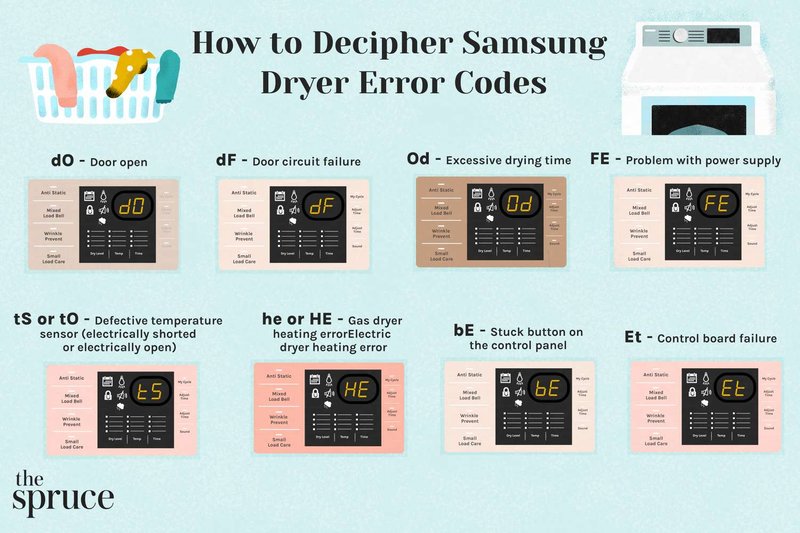
In simpler terms, when your Samsung dryer shows the Error Code HE, it’s indicating that there’s a problem with the heating process. Just as a car won’t run smoothly without gasoline, a dryer needs heat to effectively dry your clothes. When this error pops up, your dryer is struggling to heat up properly, which can leave your clothes damp and your patience thin. Don’t worry—this is a common issue, and with a little detective work, you can usually pinpoint and solve the problem. Let’s dive into some of the most common causes behind the HE error and explore what you can do about it.
Understanding the Heating Element Malfunction
At the heart of your dryer’s efficiency is the heating element, a crucial part that warms the air circulating inside the drum. Think of it as a mini fireplace powering your dryer. When the heating element malfunctions, it’s akin to trying to bake a cake in an oven that refuses to heat up—no matter how long you wait, it’s just not going to happen.
One of the primary reasons for an HE error is a faulty heating element. Over time, these elements can break or become burned out due to regular wear and tear, power surges, or simply reaching the end of their life span. If your dryer is frequently used, it’s a little like putting too many miles on a car without proper maintenance.
So how can you check if this is the culprit? One way is to visually inspect the heating element for any obvious signs of damage—like breaks or burn marks. But if you’re not comfortable doing that, it might be time to call in a professional. Replacing a heating element can be straightforward, but it’s important to have the right tools and knowledge to avoid further complications. Next time, be gentle on your dryer; regular maintenance can prevent such hiccups.
Investigating Thermostat and Thermal Fuse Issues
Picture this: a thermostat is like your dryer’s version of a climate control system, maintaining just the right amount of heat. But when it goes haywire, it can trigger that pesky HE error. If the thermostat fails, your dryer won’t be able to regulate heat properly, which might cause it to overheat or not heat at all.
The thermal fuse, on the other hand, acts as a safety net. Imagine it as a security guard that steps in when things get too hot, automatically cutting off the heat to prevent any hazards. If the fuse blows, your dryer will stop generating heat altogether. It’s like pulling the plug before a kettle boils over.
Checking and replacing a thermostat or thermal fuse often requires a bit of technical know-how. It involves testing these components with a multimeter, a tool that measures electricity flow, to see if there’s continuity. No continuity means the part is faulty and needs replacement. While it might sound a tad technical, learning to test these components can save you a lot of frustration (and perhaps some repair bills). Regularly emptying the lint trap and ensuring proper ventilation can prevent these issues from cropping up again.
Addressing Power and Circuitry Problems
Think for a moment about your home’s electrical system—it’s like the circulatory system of your house, carrying power to where it’s needed. For your Samsung dryer, any interruptions in this power flow can cause it to act up. If your dryer’s not receiving enough power due to faulty wiring or a tripped circuit breaker, it could flash the HE error code.
Imagine trying to light up a whole room with a single flickering candle—it’s just not enough. Similarly, if the circuit your dryer is connected to is overloaded with other appliances, it might not provide sufficient power. In many cases, simply resetting the circuit breaker or relocating other appliances can solve the problem.
However, if your dryer continues to display the error, it could indicate more serious electrical problems within the dryer itself. Faulty wiring, loose connections, or defective control boards can all contribute to the error code. Diagnosing these issues typically requires a qualified electrician, as tackling them without proper knowledge can be risky. Takeaway? Ensure your dryer is on a dedicated circuit to prevent these power hiccups and conduct routine electrical checks for peace of mind.
Next Steps and Preventative Measures
So, what can you do next time your Samsung dryer decides to throw an HE error tantrum? First, don’t panic. Start with the basics—turn off your dryer and restart it. A simple reset can sometimes clear minor glitches. If the problem persists, try examining each component we’ve discussed to pinpoint the issue.
Prevention is just as important as troubleshooting. Regular maintenance, like cleaning your lint filter after every use and checking the vent system for blockages, can go a long way in preventing error codes. Also, consider scheduling routine service appointments to catch potential issues before they become full-blown problems.
Remember, while fixing a dryer may feel daunting, understanding what the HE error code means and how to address it empowers you to keep your appliance in top shape. With these insights, you’re now better prepared to tackle the HE error like a pro—to ensure your dryer runs smoothly and your clothes emerge perfectly dry, every time.